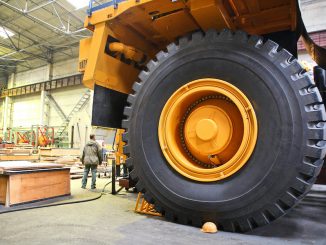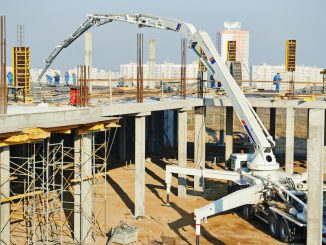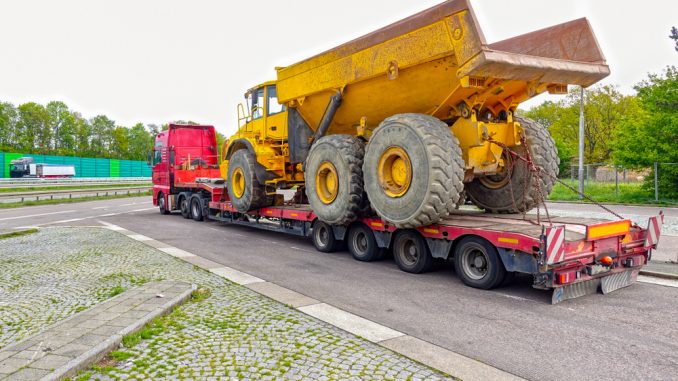
View the complete article here.
If you are in the market for a lowboy trailer, you likely have a lot of questions about how to choose the best trailer for your business. After all, a lowboy trailer is a significant investment. Purchasing the wrong one can not only cost you in the long-term, but it may also have an immediate impact on your business if you are unable to use it to haul heavy equipment and fulfill customer requests.
To avoid these consequences, take some time to research lowboy trailers in advance. Understanding the best trailer for the type of work that you do can help you avoid trailer failures — and the time and expense associated with having to replace a trailer when you could otherwise be working.
What is a Lowboy Trailer?
A lowboy is a type of trailer that has features of a semi-trailer combined with a double-level drop system. These trailers are more versatile than flatbed trailers or semi-trailers, as they can haul and carry equipment of up to 12 feet in height and between 40,000 and 80,000 pounds. Depending on the style of lowboy trailer chosen, the deck height can be adjusted to drop at the gooseneck or before reaching the wheels.
Lowboy trailers are often utilized for transporting heavy machinery, such as bulldozers, excavators, backhoe loaders, and other types of heavy equipment. Items that do not fit onto a flatbed trailer or a single-drop deck trailer can typically be hauled via a lowboy trailer.
Oversized items such as heavy machinery can more easily be loaded onto lowboy trailers because the deck can be lowered to near-ground level. In addition, depending on the style of trailer chosen, it may be loaded from either the front or the back. Alternatively, the trailer may be placed under the load and then lifted.
Most lowboy trailers are operated using hydraulic systems, with hydraulic rams lifting the trailer to meet the unit after loading. Semi-trucks tow lowboy trailers, which are equipped with air brakes.
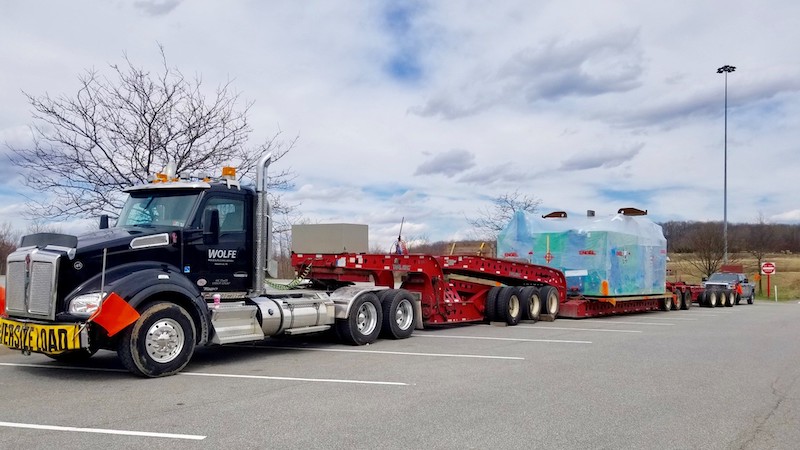
Different Types of Lowboy Trailers
There are two primary types of lowboy trailers available. The best choice for your business will depend on a number of factors, including how you intend to use it (including the weight and size of the load). They are categorized first by the height of the cargo platform and then by the style of attachment.
First, ordinary lowboy trailers have flatbed trailers with only one drop located after the gooseneck. The type of lowboy is used to transport normal heavy cargo, and cannot be used to haul cargo with a high height due to its relatively high working platform. This type of trailer is less expensive than other heavy-duty trailers, and tends to be longer in length than other heavy-duty trailers.
Second, double drop deck lowboy trailers have a lower cargo platform that is positioned lower than the rear half of the trailer. This is known as a concave beam or a staircase structure. These trailers have a high degree of stability, as the staircase lowers the height of the center of the cargo platform. Double drop deck lowboy trailers are generally used to move heavy equipment and other cargo that has a high height.
Lowboy trailers are further classified by how the gooseneck is attached to the trailer. Fixed-neck lowboy trailers have necks that are attached to the trailer itself. The main advantage of this type of trailer is that it is lightweight, which allows for a greater carrying capacity. However, given that the neck is fixed, it may be more difficult to load items onto the front of the trailer. This may make a fixed-neck lowboy a less flexible option.
In contrast, a fixed gooseneck lowboy trailer features an adjustable gooseneck. This allows heavy equipment to be loaded onto either the front or back of the trailer. The adjustable gooseneck makes loading drop decks from the rear far easier. In addition, once the gooseneck is reattached, it will ensure that any items on the trailer will stay in place.
Finally, removable gooseneck lowboy trailers allow the gooseneck to be completely removed, either technically or via a hydraulic system. Once the gooseneck has been removed, equipment can be loaded in a number of ways — from above, or by driving, rolling, pushing or pulling. Mechanically-detachable goosenecks are more lightweight, as they do not require a motor, and do not require as much maintenance. However, hydraulic goosenecks make the process of detaching the gooseneck and adjusting the trailer height far easier. Whatever lowboy trailer type you choose, it must comply with federal regulations regarding maximum dimensions (even if you have custom lowboy trailer made).
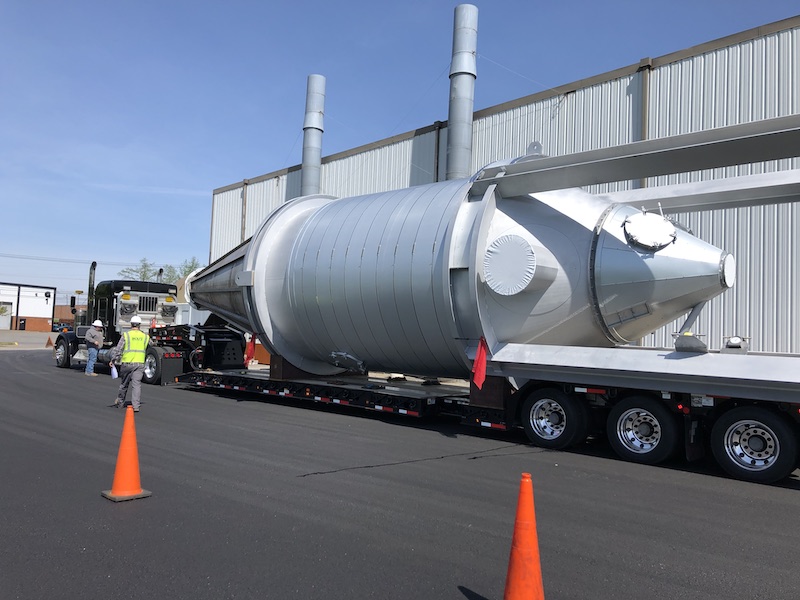
Choosing a Lowboy Trailer
Each type of lowboy trailer comes with its own advantages and disadvantages. Understanding the unique features of these trailers and how they apply to your expected use of a lowboy trailer is crucial to selecting a trailer that will serve you well for years to come. If you choose the wrong model, it can impact your business by potentially causing damage to the cargo that you carry. It may also require you to repair your trailer or to purchase a new lowboy trailer — cutting into your profits and forcing you to take downtime. The following factors should each be considered when deciding on what type of lowboy trailer to purchase.
Material
Lowboy trailers are used for the transportation of heavy equipment and other items. As such, they should be made of a material that can withstand the weight of this type of cargo. Typically, lowboy trailers are made out of steel or aluminum. The preferred choice is high-strength steel.
Aluminum is utilized in some countries for the construction of lowboy trailers. It has a lower yield strength and is more expensive than steel. However, it is very light weight, and resists rust. It is not recommended for transporting very heavy loads, and should only be used for cargo of under 50 tons in weight.
Suspension Options
When choosing a lowboy trailer, you will have multiple options for a suspension system. This includes a mechanical, rigid, air ride and single point. The type of suspension used will primarily depend on the weight capacity of the trailer.
Mechanical suspensions involve a series of reaction arms that keep the axles horizontal at all times. This makes mechanical suspensions highly stable, with load distribution remaining constant. Mechanical suspensions are best used for heavy-duty trailers. They are both inexpensive and reliable, as well as easy to maintain.
Rigid suspensions are primarily used in heavy-duty lowboy trailers, and are best used for low speed transportation. With this type of suspension, the movement of one wheel is dependent on the movement of the other wheels. Rigid suspensions are inexpensive and easy to install and maintain. They improve stability and wheel alignment, and can improve the service life of tires. However, rigid suspensions have a poor damping effect, and drivers cannot adjust ride height for either empty or loaded trailers.
An air ride suspension is lighter than other type of suspension. It also offers good stability, and is more flexible than other options because the stiffness of the spring adjusts to the weight of the cargo. This type of suspension offers better fuel economy and longer tire life. In addition, reduced vibration leads to less wear and tear on the trailer. The biggest drawback to air ride suspensions is that they are costly.
Single point suspensions are useful for trailers that carry very heavy cargo of up to 100 tons. This type of suspension has a good damping effect, and reduces vibrations to the trailer, decreasing wear and tear on the lowboy. However, single point suspensions are costly.
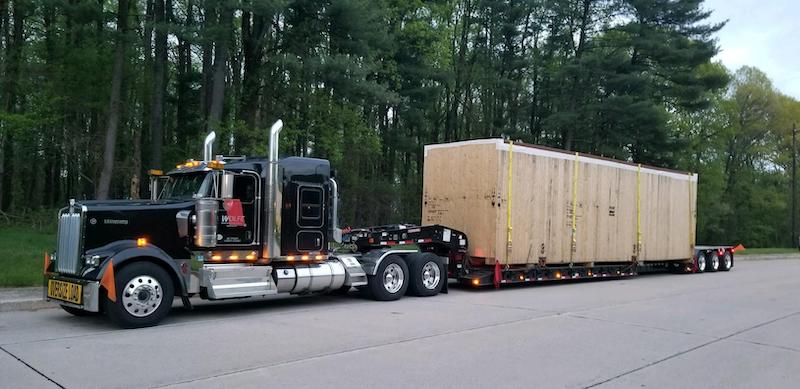
Tires
There are two types of tires that are used on lowboy trailers: tube tires and tubeless tires. The type of tire that you should choose will depend on how you intend to use the trailer.
Tube tires are stable on rough terrains, and can support heavy loads because they are pressurized. It is also relatively simple and cost-effective to repair a tube tire. However, a tube tire is more prone to blowouts when pierced. This type of tire tends to have a shorter service life.
In contrast, tubeless tires are less likely to blow out if they are pierced; instead, a tubeless tire will slowly leak pressurized air. These tires reduce the weight of a lowboy trailer and reduce fuel costs. Tubeless tires also have a long service life, and good wear resistance, so they can be used for long distance transportation. However, they are not suitable for heavy loads because they are unpressurized. They are not suitable for rough terrains due to poor stability. Finally, it is difficult and costly to repair tubeless tires.
Carrying Capacity
In addition to classification by their attachment style, lowboy trailers are categorized by the tonnage that they can carry. There are two options for lowboy trailers: a 25 ton (50,000 pounds) or a 35 ton (70,000 pounds) carrying capacity.
Importantly, the carrying capacity of a lowboy trailer is determined based on the net carrying capacity, not solely on the weight of the load carried. For example, if the trailer itself weighs 35,000 pounds and has a 25 ton (50,000 pounds) carrying capacity, it can only carry a total of 15,000 pounds. For this reason, the total weight of the trailer should be taken into consideration when purchasing a lowboy trailer.
When buying a lowboy trailer, the first and most important consideration should be the maximum amount of weight that you intend to transport with the trailer. The appropriate trailer should have the capacity to haul that weight.
Hydraulic or Mechanical
A removable (or detachable) gooseneck lowboy trailer is available in either a hydraulic or mechanical option. While most contractors choose hydraulic goosenecks for ease of use, there may be some situations where a mechanical gooseneck is preferred.
Hydraulic goosenecks utilize a series of hydraulic cylinders to lower the deck when the trailer is attached to the truck. This type of trailer allows operators to lower and lift the deck easily using the cylinders. It also allows the operator to keep a low center of gravity when the loaded equipment is particularly tall. The major disadvantage of hydraulic goosenecks is that they add a fair amount of weight to the trailer, decreasing its overall carrying capacity. Hydraulic goosenecks are the most commonly-used type of lowboy trailers.
Mechanical goosenecks are more difficult to operate, but are much lighter weight than hydraulic goosenecks. They are also less expensive than hydraulic goosenecks, and require less maintenance. There are two main designs of mechanical goosenecks: versions that require a tractor to ram into the trailer, and those that require a winch to be mounted to the tractor. These types of goosenecks are best suited to longer-distance trucking companies, where the load will be on the truck for several days and unloading will occur on smooth, hard surfaces.
A lowboy trailer is a substantial investment in your business. When selecting a trailer, be sure to carefully consider what type of cargo you will need to carry, price, the weight and size of the cargo, maintenance costs, loading process, and future business needs. Based on a thorough analysis of these factors and an understanding of the types and features of lowboy trailers available, you will be able to make an informed decision about the best trailer for you.
View the complete article here.
What is a lowboy trailer, and what types of equipment can it transport?
A lowboy trailer is a specialized trailer with a double-level drop system, capable of hauling heavy equipment up to 12 feet in height and weighing between 40,000 and 80,000 pounds. It is often used for transporting machinery like bulldozers, excavators, and backhoe loaders.
How do I choose the right lowboy trailer for my business, considering factors like material, suspension options, tires, carrying capacity, and gooseneck type?
To choose the right lowboy trailer, consider factors such as material (steel or aluminum), suspension type (mechanical, rigid, air ride, or single point), tire type (tube or tubeless), carrying capacity (25 or 35 tons), and gooseneck type (hydraulic or mechanical) based on your specific cargo, operational needs, and budget.






































